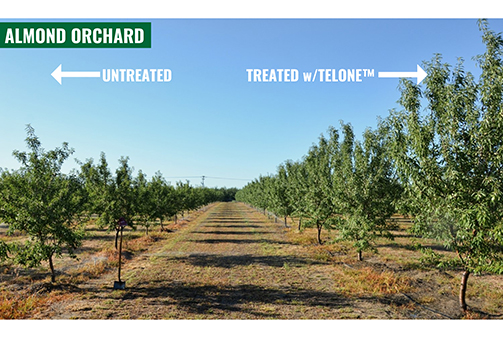Studies Show Accede PGR Excels at Thinning Even After Freezes
A second year of research conducted by Penn State University (PSU) further supports the efficacy of 1-aminocyclopropane-1-carboxylic acid, or ACC, as a registered chemical thinner for peach and nectarine.
Marketed under the name Accede (Valent USA), the plant growth regulator (PGR) is available in most prominent fruit-growing states as a 10% liquid formulation that targets apple and stone fruit.
James Schupp, a Professor of Pomology at PSU, conducted research on ACC in 2021 and 2022. He compared the two growing seasons while presenting in early December at the Great Lakes Fruit and Vegetable Expo in Grand Rapids, MI.
ROUGH START, OPPORTUNE FINISH
Two serious cold fronts affected the 2022 season, whereas the 2021 campaign had transpired uneventfully. The first freeze event, in November 2021, injured and eventually reduced some ‘John Boy’ peach buds at the ends of fruiting laterals. The “real damage was done” in late March, Schupp says, while the fruit buds were at the swollen green bud stage.
“We got down to 19ºF a couple nights in a row, and it definitely did some thinning,” Schupp says. “A decision was made that we had enough viable flowers that we should go ahead — and we did.”
As ironic as it might have been, the decision wound up boding well. While many growers would have figured blossom thinning was overkill after such freezes, sticking with the trial despite the up-front plant damage only heightened ACC’s fledgling stature.
“This is kind of showing you the effects of doing this in a year where you, as a commercial grower, might have been thinking twice about putting any blossom thinners out after what Mother Nature had done,” Schupp says. “But we deemed that there were enough viable flowers in there that we went ahead and did it. And it worked out that way.”
AND THOSE EFFECTS WERE?
The 2022 research tested ACC rates of 600 parts per million (ppm) at 10% open bloom (early), 50% open bloom (mid), and 90% open bloom (late); and split applications of 300 ppm at 10% and 50% open bloom, 50% and 90% open bloom, and 10% and 90% open bloom.
All six ACC treatments reduced initial fruit set; the earliest ones seemed to thin the most initially, according to Schupp. All six treatments also reduced final fruit set similarly, between 34% and 52%, with 300 ppm early and late accounting for the latter percentage.
“All the others were just about the same,” Schupp says. “Timing this year was not a real important factor in efficacy, at least in the long run.”
The ACC sprays also reduced the minutes-per-tree hand thinning rates by 20% to 49%, “even in a year where you had some crop loss,” Schupp says.
In terms of yield, 600 ppm of ACC early or late and 300 ppm mid to late led to reductions. Contrary to 2021, there were no differences in fruit size at harvest in 2022, as 73% to 83% of fruit in the study were 3 inches or larger. Fruit size was not improved by ACC thinning in 2022, as the crop was not resource-limited due to the March freeze.
As for the 2021 research, results included:
- Mild thinning of ‘John Boy’ with 300 ppm at early bloom.
- Strong thinning with 600 ppm.
- Mild thinning at pink with 500 ppm.
- Reduced hand thinning time by 28% with 300 ppm, 55% with 600 ppm, and 44% with 500 ppm at pink.
- The larger size of thinned fruits demonstrated the benefit of early thinning at bloom.
- After supplemental hand thinning, the yield of 300 ppm was similar to UTC while the yield of 600 ppm was 35% lower.
- Fruit size was increased by thinning with ACC.
“My understanding is that ACC will be more widely available this year, but there may not be enough Accede out there for everyone,” Schupp says. “So I would encourage you to talk with your chem rep and make sure that, if you’re interested in trialing this material this year, you can get some.”










